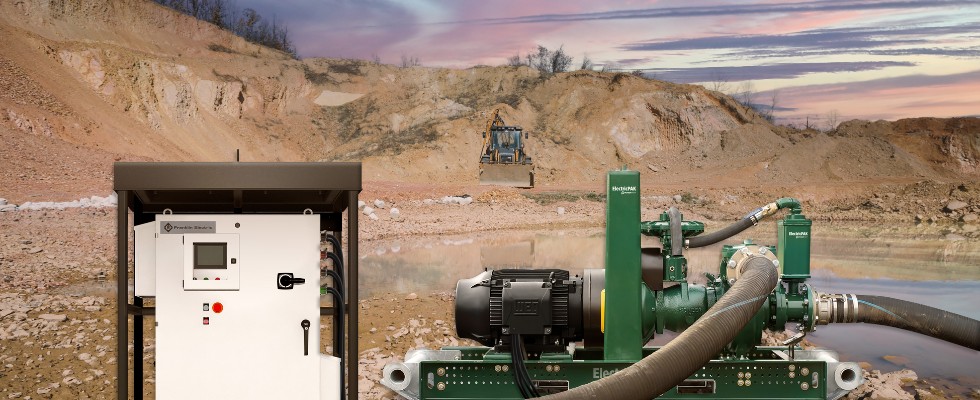
Surface pumps and submersible pumps share some similarities in terms of performance for dewatering applications. Both have portable configurations and can be easily transported around job sites. Both offer a range of hydraulics to meet various dewatering application requirements, including a variety of high head and high flow options. But what else is important to the application?
There are several variables to weigh when deciding between a surface or a submersible pump, and evaluating these variables can help users make the best decision for their application needs.
1. What is the suction lift for the application?
Suction lift is the distance between the suction centerline of a surface pump and the surface of the liquid. Every pump has a minimum inlet pressure requirement (NPSHr) that is affected by the suction lift. As a general rule, a surface pump works best when static suction lift is 25 feet or less. These pumps are a good option for portability and maintenance access, and they allow users to pump down completely—for example, in a creek or stream bypass application.
If the suction lift is greater than 25 feet or NPSH issues are a concern, a submersible may be a better choice.
2. What are the site constraints?
The site itself can play a big role in the pump that is chosen. Is there room close to the water’s edge for a pump? Is there room to run suction and discharge hoses? If there is no easy access to the water source due to topography or power availability, a surface pump can provide flexibility. Surface pumps can utilize a suction hose to draw water from the source. Again, users will need to consider the NPSH, as increasing suction hose length reduces the NPSH available.
In many dewatering situations, there is also limited real estate for pumping equipment. This can create issues with surface pumps, which often occupy a large footprint. If running hoses to and from the dewatering area, these can also cause space issues since hoses can be long, heavy and bulky. They can get in the way of other equipment on the site, making it hard for crews to navigate heavy machinery. In some cases, crews may inadvertently damage hoses or the pumping equipment. A submersible can overcome some of these issues since it occupies a smaller footprint compared to a surface pump.
3. How quickly does the water need to be moved?
If dewatering for flood control, moving high volumes of water quickly is essential. In other situations, like construction dewatering, moving a steady flow of water may be all that is needed. That is why it is important to consider the flow rate required for the job.
If a user needs to move a large volume of water, surface pumps have the advantage. With their larger size, they can achieve higher flow rates—as much as 20,000 gallons per minute (gpm) or more depending on size. While some of these large volume pumps may require special equipment to transport and install, their pumping power makes them critical in high-volume dewatering situations. This is why portable surface pumps are the first types of equipment called in after a major weather event like a hurricane.
4. What power source is available?
Most submersible options require electricity for power. Surface pumps are available in electric- or diesel-driven options. Diesel engines tend to have higher maintenance and fuel costs but are ideal for remote areas without easy access to grid power or generators. Make sure to look at the manufacturer’s package curve for guidance on whether the engine and pump will work for the specified application. If a package curve does not exist, check with the manufacturer to ensure the engine will be adequately loaded. This will help prevent issues with engine aftertreatment systems.
5. How often will the pumping system need to be serviced?
Depending on the site and pump usage, users may want to consider how often the equipment will require service. Pumps that are used heavily will require scheduled maintenance. Since submersibles are fully submerged under water, pulling the system for service requires more equipment and time. Surface pumps are generally more accessible for servicing.
6. Does noise control need to be considered?
If the site is located near a population center or residential area, it is important to control noise pollution. Submersible pumps operate with a low hum, minimizing their impact on people and the surrounding environment. Diesel-driven surface pumps are noisier. Some diesel packages are available with sound attenuated enclosure options that typically reduce noise to 70 A-weighted decibels (dBA) or lower.
7. What types of solids handling will be needed?
Both submersible and surface pumps have solids handling capabilities but vary in the types of solids they can tackle without clogging. As a rule, surface pumps can handle larger solids better than submersibles. Many 4-inch and z6-inch surface dewatering pumps can typically handle 3-inch spherical solids, and large surface pumps or vortex-style pumps can handle even larger solids.
From mining to construction, flood control during inclement weather to a new infrastructure project, dewatering is critical for many industries. Weighing options comes down to asking the right questions for each situation.
For example, a construction site might not have enough surface real estate to eliminate water around building footers. If power is available, a submersible pump could make the most sense. If the site experiences a major weather event like heavy rainfall, water will need to be moved quickly to a nearby retention basin or other storage system. In this case, a surface pump may be the best option to get the job done.
Every application is unique, and needs can vary from site to site. Considering all the variables at play will go a long way in ensuring users have the best equipment for the situation and get the performance they need from their pump.

